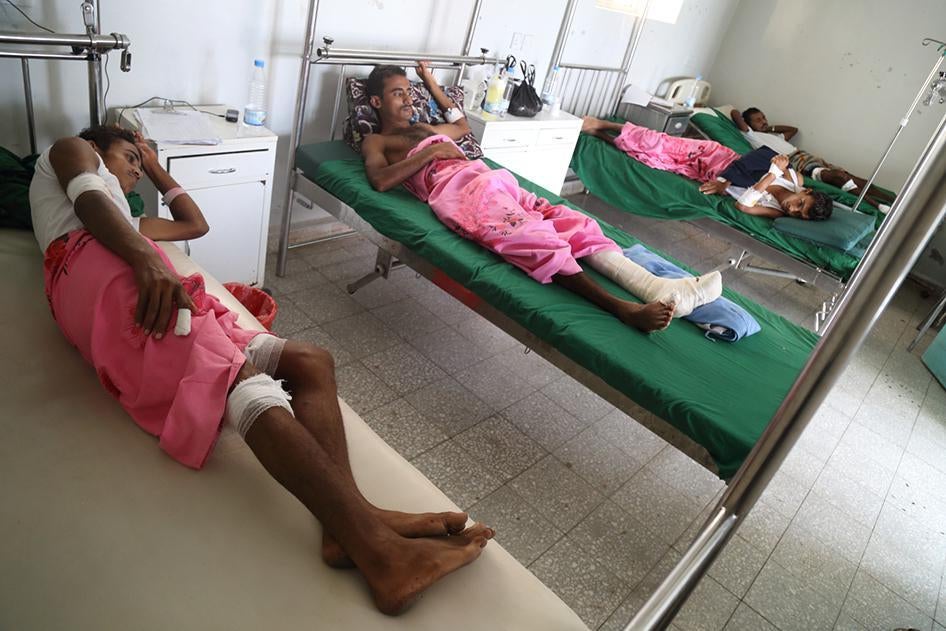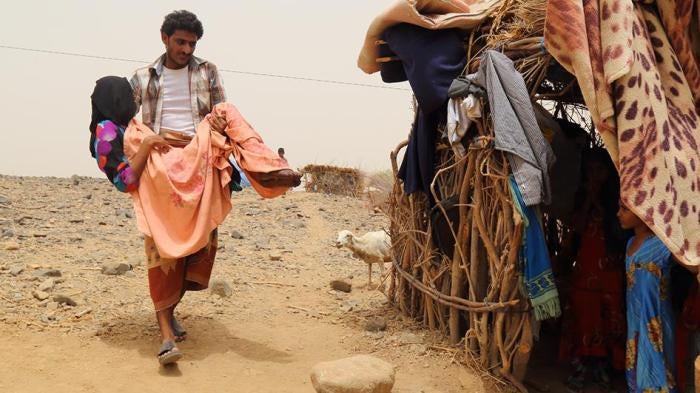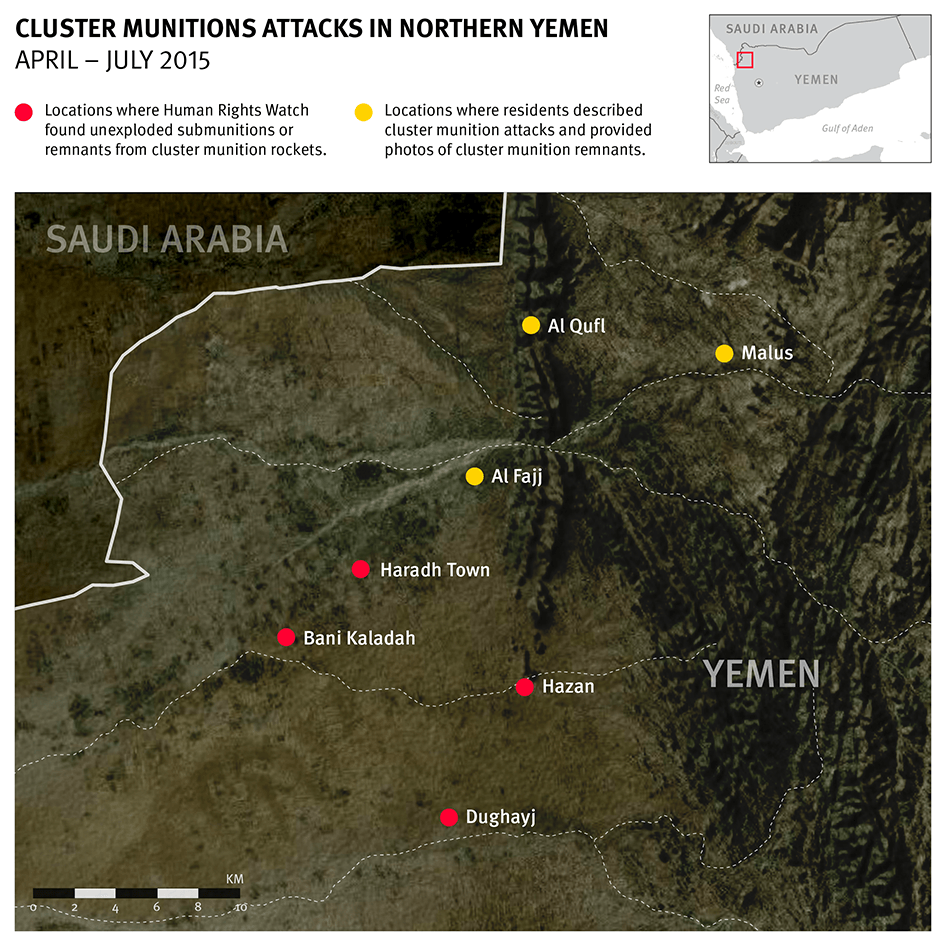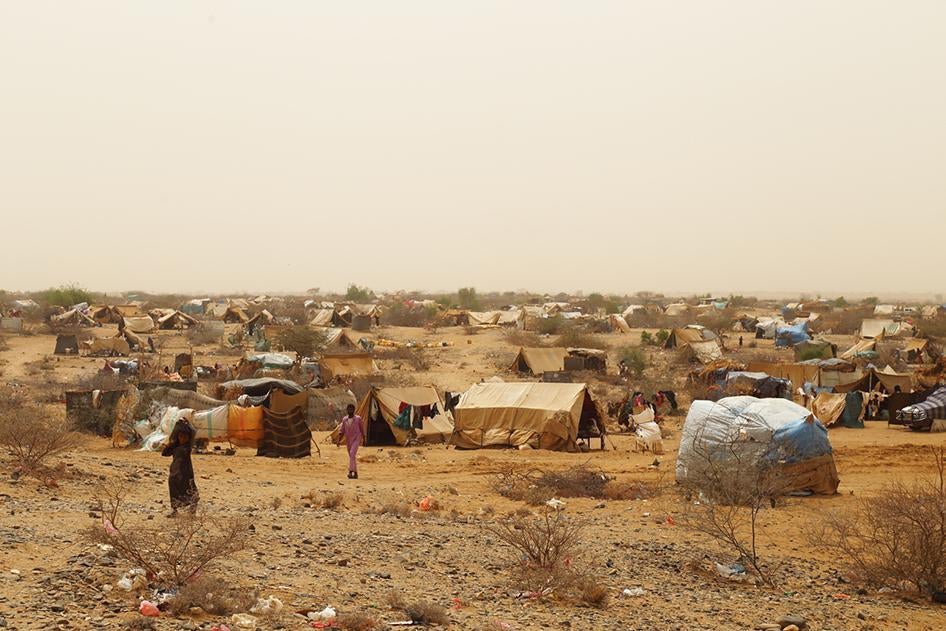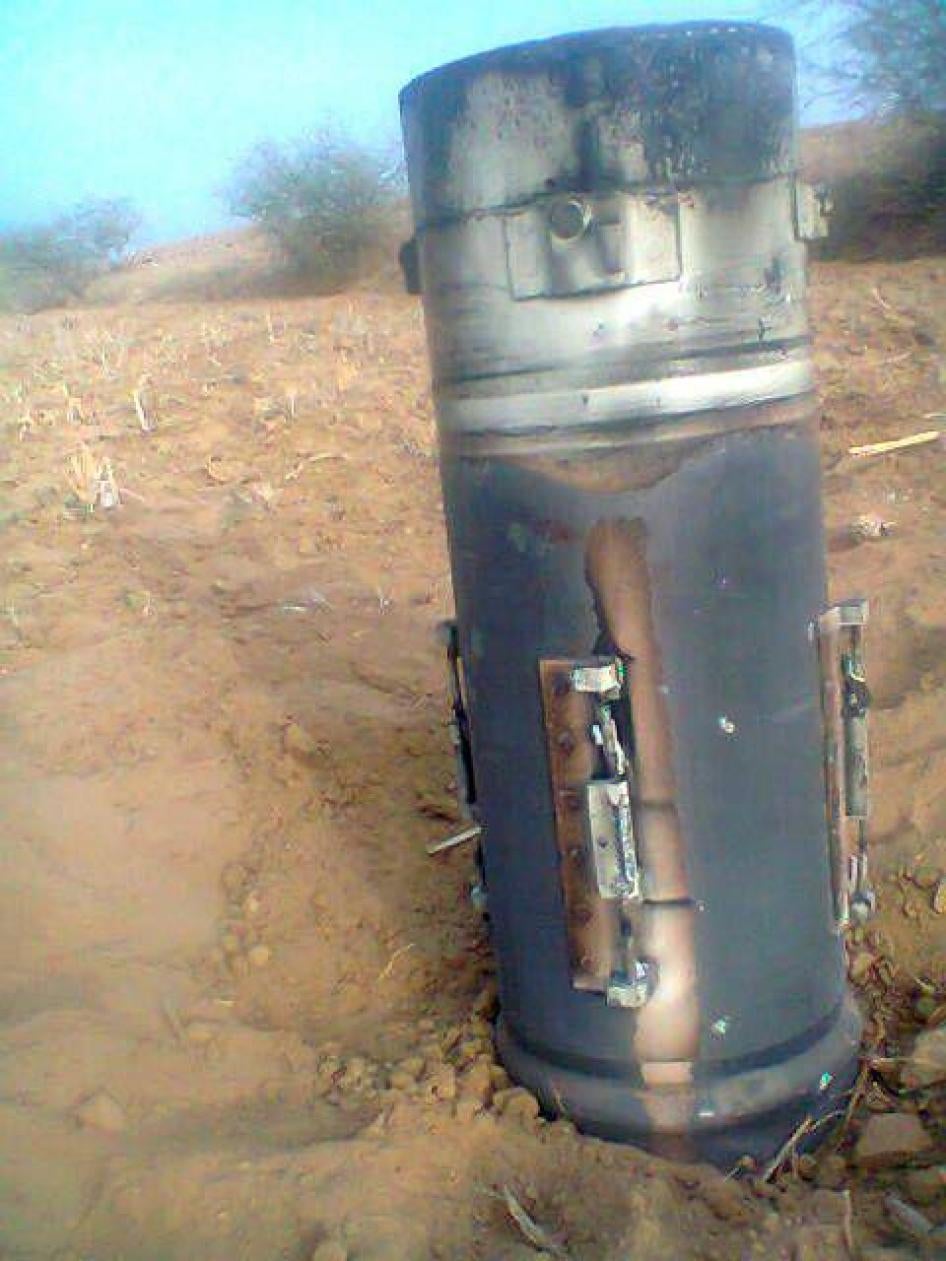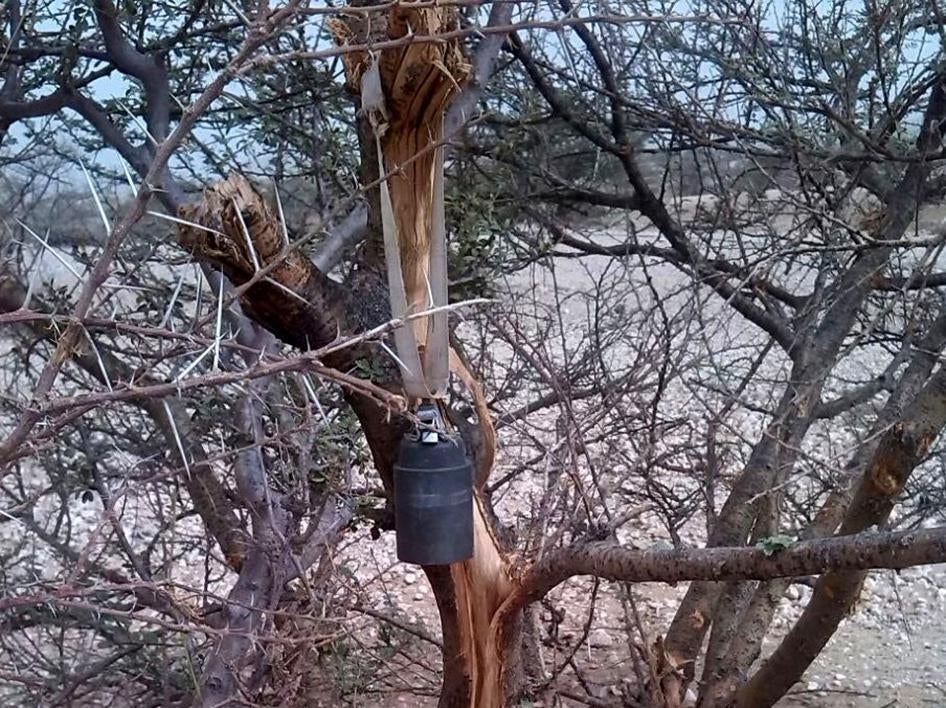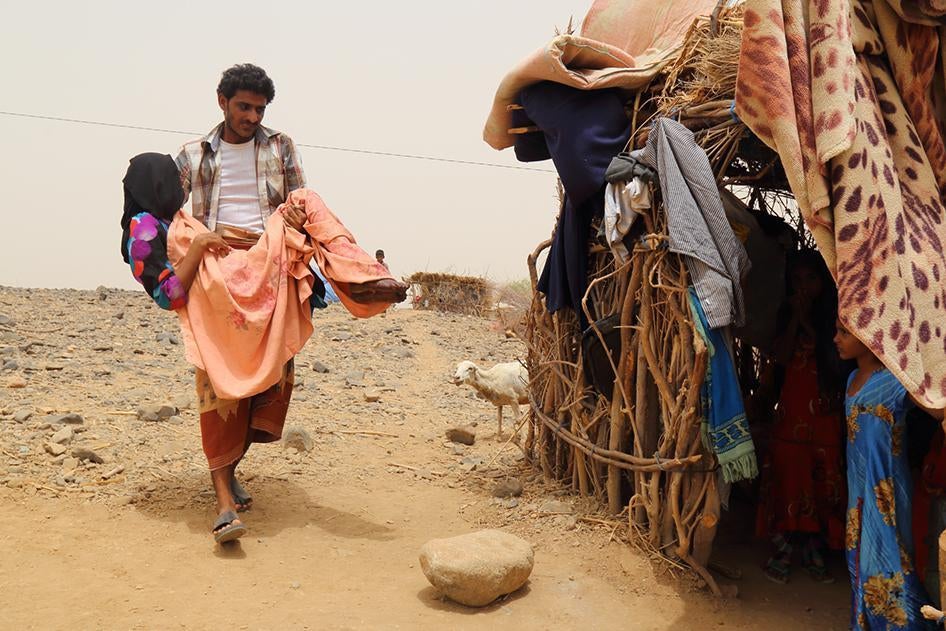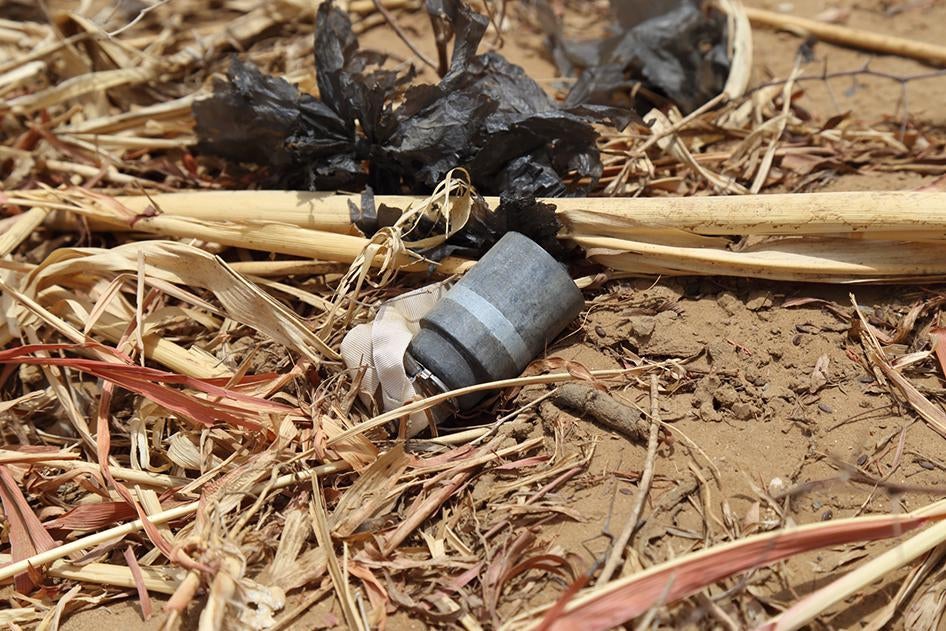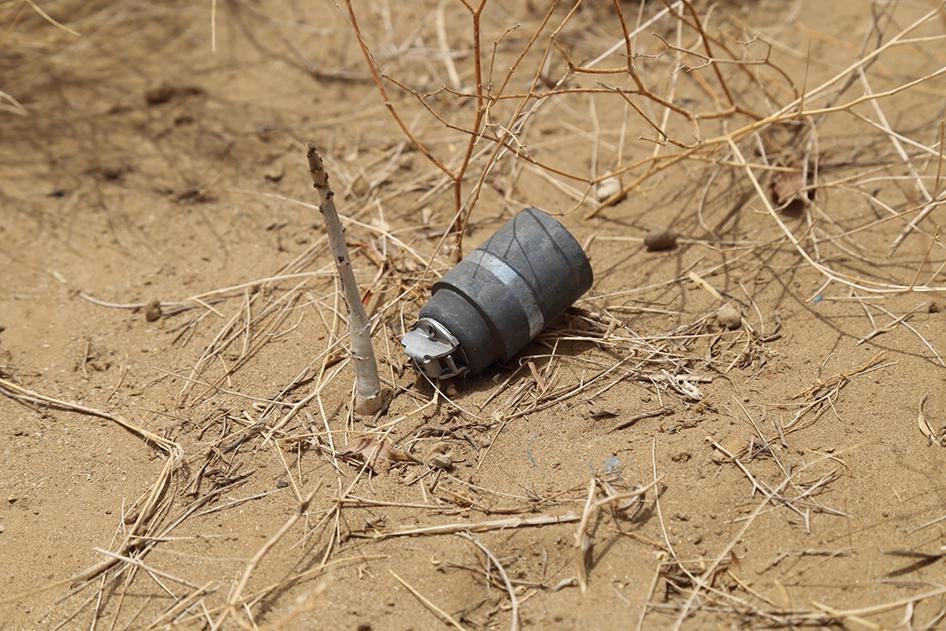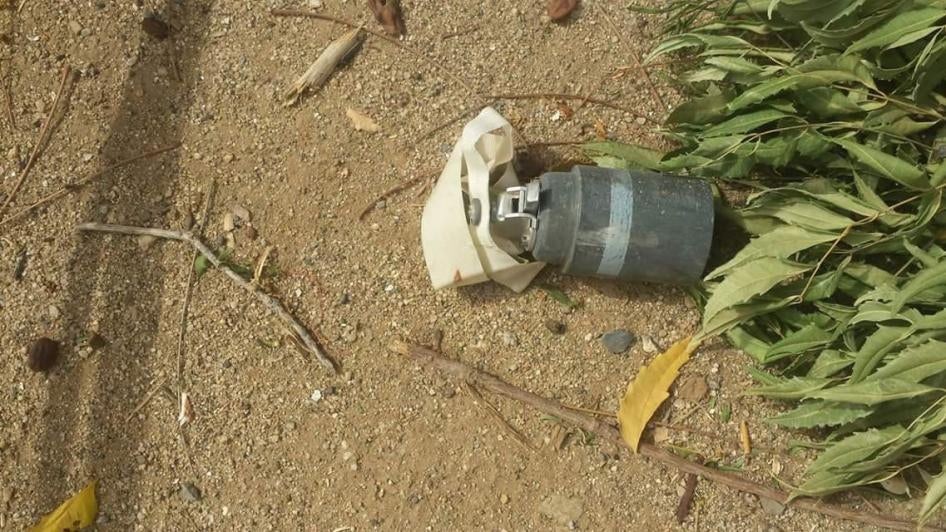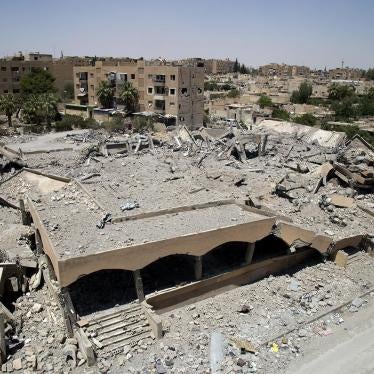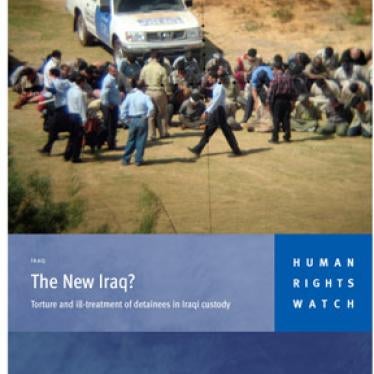(Beirut) – Saudi Arabia-led coalition forces appear to have used cluster munition rockets in at least seven attacks in Yemen’s northwestern Hajja governorate, killing and wounding dozens of civilians, Human Rights Watch said today. The attacks were carried out between late April and mid-July 2015.
Cluster munitions caused civilian casualties both during the attacks, which may have been targeting Houthi fighters, and afterward, when civilians picked up unexploded submunitions that detonated. Coalition forces should immediately stop using cluster munitions due to the inevitable harm they cause to civilians, Human Rights Watch said. The United Nations Human Rights Council should create a commission of inquiry to investigate alleged serious laws-of-war violations by all parties to the armed conflict in Yemen since September 2014.
“The loss of civilian life in Hajja shows why most countries have made a commitment never to use cluster munitions,” said Ole Solvang, senior emergencies researcher. “These weapons not only kill or injure people at the time of attack, but the unexploded submunitions go on killing long afterward.”
Since March 26, a coalition of nine Arab countries has carried out a military campaign against the Houthis, also known as Ansar Allah. The Houthis, a Shia armed group from northern Yemen, took control of large parts of the country and ousted President Abu Mansur Hadi earlier in 2015.
In July, Human Rights Watch visited four of the seven attack sites, all in the Haradh and Hayran districts of Hajja governorate. At each of them, Human Rights Watch found unexploded submunitions or remnants of cluster munition rockets. Human Rights Watch also spoke to local residents who witnessed the attacks, and reviewed photographs of cluster munition remnants, including unexploded submunitions, that they provided. The photographs showed unexploded submunitions from two sites that Human Rights Watch did not visit.
Several of the attacks took place in or near areas with concentrations of civilians, indicating that the rocket attacks themselves may have been unlawfully indiscriminate in violation of the laws of war. Local residents named 13 people, including 3 children, who were killed as well as 22 people who were wounded in the seven attacks. They also identified three people who were injured when unexploded submunitions detonated after being handled. In several attacks, residents said, the number of killed and wounded was higher, but that they did not know the names of the other victims. Human Rights Watch does not know whether any Houthi fighters were killed or injured in the attacks.
Human Rights Watch found unexploded submunitions scattered about in fields normally used for agriculture and grazing. Because of the unexploded submunitions, these areas have become too hazardous to use, threatening the livelihoods of local farmers and adding to food insecurity.
Based on examination of remnants, Human Rights Watch identified the weapons used in all seven attacks as United States-made, ground-launched M26 cluster munition rockets. The M26 is delivered by the M270 Multiple Launch Rocket System (MLRS), which carries 12 rockets, or the M142 High Mobility Artillery Rocket System (HIMARS), which carries 6 rockets, to a range of 10 to 32 kilometers.
Each M26 rocket contains 644 M77 Dual Purpose Improved Conventional Munitions (DPICM) submunitions that are dispersed over a 200-by-100 meter area. A volley of six rockets releases 3,864 submunitions over an area with a one-kilometer radius.
The M77 submunitions have a significant failure rate, up to 23 percent in US military testing, which means that unexploded bomblets remain in the area, posing a serious hazard until they are located and safely cleared. Several residents described or showed Human Rights Watch remnants of the weapons, including their distinctive white nylon stabilization ribbons, which often remain after the submunition has exploded.
Although the evidence is not definitive, several factors indicate that the Saudi-led coalition carried out the seven attacks, Human Rights Watch said. Coalition members Bahrain, Egypt, and the United Arab Emirates all possess M26 rockets and their launchers, though there is no authoritative publicly available information that Saudi Arabia or Yemen do. Media reports suggest that Egyptian and Emirati forces might be deployed in Saudi Arabia, but Human Rights Watch was not able to confirm this.
The attack sites are between 4 and 19 kilometers from the Saudi-Yemeni border, within range of attack by forces located in Saudi Arabia. One Yemeni in a village 20 kilometers from the border said he saw rockets coming from the direction of the border.
The rockets struck in Houthi-controlled territory, at least three in areas that Houthi forces had used as bases or to launch attacks against Saudi territory and that would be likely targets for coalition forces. A Saudi reporter shared on social media a photograph of a failed M26 rocket containing M77 DPICM submunitions that he said he took in Saudi Arabia’s adjacent Jizan province, claiming that Houthi forces launched it. The photograph shows, however, that part of the rocket’s propulsion section is missing, indicating that the rocket misfired after being launched. It is therefore not possible to conclude the target of this rocket based on the location alone.
Saudi authorities have not responded to an August 18 written request from Human Rights Watch to clarify responsibility for the attacks.
Local Yemeni residents told Human Rights Watch that they had heard of similar cluster munition rocket attacks in other locations in northern Yemen, but Human Rights Watch has not been able to investigate these reports due to ongoing fighting. A photograph shared on social media on July 2 that accompanying text said was taken in the district of Razeh in Saada governorate showed a child holding two unexploded M77 DPICM submunitions. The photograph suggests that M26 cluster munition rockets might have been used there as well.
Human Rights Watch has previously identified three other types of cluster munitions used in attacks apparently by coalition forces in Yemen in 2015: US-made CBU-105 Sensor Fuzed Weapons, rockets or projectiles containing “ZP-39” DPICM submunitions, and CBU-87 cluster bombs containing BLU-97 submunitions. A US Defense Department official, speaking on the condition of anonymity, reportedly told U.S. News and World Report that “the U.S. is aware that Saudi Arabia has used cluster munitions in Yemen.”
Neither Yemen, Saudi Arabia, nor any of the other coalition states are party to the 2008 international treaty banning cluster munitions. A total of 94 countries are parties to the Convention on Cluster Munitions and another 23 have signed but have not yet ratified the convention. Human Rights Watch is a co-founder of the Cluster Munition Coalition and serves as its chair.
“Cluster munitions are adding to the terrible civilian toll in Yemen’s conflict,” Solvang said. “Coalition forces should immediately stop using these weapons and join the treaty banning them.”
Al-Qufl Village, Haradh District
On the morning of July 14 or 15, members of the Hayash family were taking their cows and sheep to graze in fields surrounding the village of al-Qufl when they witnessed a cluster munition attack. Al-Qufl is about 13 kilometers northeast of Haradh, a town in the governorate of the same name, and just 4 kilometers from Yemen’s border with Saudi Arabia. Aziz Hadi Matir Hayash, 15, told Human Rights Watch: “We were still close to the house when the rocket exploded in the air and … [sub]munitions fell out of it. Two landed near our house while others spread all over the village. One exploded and the other is still there.”
The submunition that exploded near the Hayash family’s house fatally wounded Hayash’s brother, Khaled Matir Hadi Hayash, 18, in the neck, and wounded Aziz Hayash and three of his cousins. Human Rights Watch met Hayash and his three cousins in a hospital in Hajja City on July 24, where they were being treated for their injuries. The attack also killed 30 sheep as well as their cows, Hayash said.
Aziz Hayash’s cousin Saria Muhammad Hayash, 24, said that the unexploded submunition was the size of a small medicine bottle with a white ribbon attached to it, a description consistent with the M77 DPICM submunition. He said he had seen perhaps 10 such unexploded submunitions in the area.
A resident from a neighboring village said that five people had died in an attack on al-Qufl village. He may have been referring to the same cluster munition attack because he mentioned that members of the Matir family, a name also used by the Hayash family, were among the victims, but he could not recall the date.
Malus Village, Haradh District
Just before midnight on June 7, cluster munitions were used in an attack on the village of Malus in the al-Fag directorate of Haradh District, local residents told Human Rights Watch. Malus is 30 kilometers east of the town of Haradh and 5 kilometers south of Yemen’s border with Saudi Arabia.
Human Rights Watch interviewed 11 people from Malus, including five who were injured in the attack, in a camp for displaced people in Hayran District. The Malus residents provided the names of seven local people, including three children, who were killed in the attack, and another 17 who were wounded.
Muhammad al-Marzuqi, 30, who sells qat (a leaf widely consumed in Yemen as a stimulant) in Malus, said that he looked out the window after hearing explosions in the village:
I saw a bomb exploding in the air and pouring out many smaller bombs. Then an explosion threw me on the floor. I lost consciousness and somebody transferred me to the hospital with burns and wounds on the heels of the feet and fragmentation wounds on the left side of my body.
The attack also wounded two of his children. Ismail, 13, showed Human Rights Watch a scar on his inner, upper left thigh that had resulted from surgery to remove fragments. Saria, 9, showed a scar on her right knee, which was still stiff from the injury.
Muhammad Rabi said his 13-year-old son was fatally wounded in the attack: “I took him to the hospital, but he died as soon as we arrived. I stayed with him till the morning, then buried him in Hayran. I didn’t even take him back home. Residents of the village all fled. You can’t find anyone there now.”
Human Rights Watch also interviewed Fatima Ibrahim al-Marzuqi, whose legs were injured in the attack. Despite several operations, she still could not walk. Her brother Yahya Ibrahim al-Marzuqi, 22, who was also wounded in the attack, has been carrying her.
Muhammad Swaid al-Marzuqi, about 70, said:
I was sleeping a few meters from my son’s grocery shop when I heard the explosions. I got up and saw the shop was burning, and then I saw burning fires and smoke in many locations in the village and understood that the whole village had been attacked.
The villagers said that at least two submunitions failed to explode; one was found on a road and another hanging from a tree branch. One villager provided photographs that he said he had taken in and near the village. The photographs show an unexploded M77 DPICM submunition hanging from a tree and the remnants of several M26 rockets. At an ad hoc camp for displaced people in Beni Hassan, a Malus resident showed Human Rights Watch a piece of a white ribbon from an M77 DPICM submunition that he had found in the village after the attack.
Dughayj Village, Hayran District
Cluster munition rockets were used in an attack on the village of Dughayj in the Hayran district, 20 kilometers from Yemen’s border with Saudi Arabia, in late June or early July, local residents told Human Rights Watch.
Adel Hassan, 15, a Dughayj resident, told Human Rights Watch researchers who visited the village on July 27 that the attack took place at about 1 p.m. “less than a month” earlier. He said the attack killed about 10 people, all civilians, and wounded 30 others. He named five of the dead, including three women, but said he could not identify other victims, most of whom had come to Dughayj after being displaced from other areas by the conflict.
Hassan said that he saw 10 unexploded submunitions after the attack and that his cousin had destroyed others. Local residents said that Houthi forces had removed unexploded submunitions from the village. Nevertheless, during a visit to the village on July 27, Human Rights Watch found an unexploded M77 DPICM submunition.
Other local residents confirmed the attack and a resident of the neighboring Haradh District said that a villager from Dughayj had brought him an unexploded submunition after the attack.
Al-Hazan Village, Haradh District
Cluster munition rockets hit agricultural land near the village of al-Hazan in the Hayran district, 20 kilometers from the Saudi-Yemeni border, in late May or early June.
One villager said that on the night of the attack he saw flashes from rockets that appeared to have come from the direction of Yemen’s border with Saudi Arabia. Shortly thereafter, he saw multiple flashes in the air above the village, followed by dozens of explosions, “like the sound when you dump a load of rocks from a truck.”
The submunitions fell in farming land belonging to three villages, which have a combined population of about 3,000.
The attack injured one man, who had been displaced from another village by the war, in his chest and back, the villagers said. Unexploded submunitions in the fields subsequently detonated after being disturbed and injured three farmers in separate incidents: a 17-year-old was injured in his abdomen, a 70-year-old man in his legs and hand, and a 31-year-old man in his leg.
A farmer showed Human Rights Watch the fields where the submunitions landed, where dozens of small craters remained visible in the soft soil. Human Rights Watch found three unexploded M77 DPICM submunitions, as well as pieces of the white stabilization ribbons from submunitions that had exploded. One submunition was almost completely buried in the sand with only part of the ribbon visible. Another was on a path between two fields with a rope tied to the white ribbon, apparently by someone trying detonate it by yanking on the ribbon.
The presence of unexploded submunitions in the fields is having a negative effect on farmers’ livelihoods, locals said. “We can’t work the fields anymore because of the submunitions,” said Ali Muhammad Gahshor, 52.
Some villagers said that Houthi forces were using a nearby house at the time of the attack and might have been its target.
Bani Kaladah Village, Haradh District
Cluster munition rockets were used in attacks near the village of Bani Kaladah in Haradh District, 5 kilometers west of Haradh and 7 kilometers from the Saudi-Yemeni border, in late April or early May.
One villager said that his brother found 12 unexploded submunitions near their family home when he returned to the village on May 13. The submunitions had landed in the fields, affecting at least 10 farms, the villager said.
The villager sent Human Rights Watch photographs that he said a friend had taken in fields near his house. The photographs showed remnants of at least one M26 rocket and one unexploded M77 DPICM submunition.
On July 27, Human Rights Watch went to see the villager’s house where the 12 submunitions were said to have been found but the house had been reduced to rubble, apparently from one or more bombs, making it unsafe to search for unexploded submunitions. Human Rights Watch found the remnants of an M26 rocket about a kilometer north of the house. One local resident said that Houthi forces had cleared the area of unexploded submunitions after the attack.
A resident said that Houthi forces were using local roads, abandoned houses, and farmland to launch attacks against Saudi forces, and had told residents to vacate the area on April 5. The local council had also signed an agreement with the Houthis declaring the area a military zone, he said, although some civilians remained in the village.
Haradh Town, Haradh District
Cluster munition rockets were used in an attack on the outskirts of Haradh, a town 11 kilometers from the Saudi-Yemeni border, on July 25, Houthi fighters and a local medical worker told Human Rights Watch. Human Rights Watch found cluster munition remnants at the site two days after the attack.
A medical worker at Haradh’s hospital said that cluster munitions were used in an attack on the western part of town on July 25 and showed Human Rights Watch photographs of two unexploded M77 DPICM submunitions that she said were found in the impact area. The medical worker said the submunitions fell over a large area around the road leading to the port town of Midi.
Inspecting the site on July 27, Human Rights Watch found that some submunitions appeared to have hit close to a Houthi-run military checkpoint. A Houthi fighter patrolling the road in the area at the time of the attack told Human Rights Watch that the cluster munition attack occurred at about 5 p.m. on July 25:
I heard a massive explosion in the air and I saw a red flash followed by a series of explosions on the ground. Many submunitions fell on houses, but they were empty because most Harad residents had already left.
The Houthi fighter showed Human Rights Watch a bucket containing five unexploded M77 DPICM submunitions that he said had been collected from around the checkpoint.
Al-Fajj Village, Haradh District
A local resident said that cluster munition rockets hit his father’s farm in al-Fajj village about a month before Human Rights Watch spoke to him in an area for displaced people in Hayran district on July 25. Al-Fajj is 5 kilometers northeast of Haradh and 10 kilometers south of Yemen’s border with Saudi Arabia.
The cluster munition rocket attack killed at least one woman and wounded her husband, he said.
The resident said that he saw unexploded submunitions at his father’s farm as well as at other farms and in the mountains nearby. He said that the submunitions had white ribbons attached to them and that their bottom was hollow with a reddish color, a description consistent with M77 DPICM submunitions. He said that he destroyed one submunition by throwing it against a wall, causing it to explode.
An acquaintance shared two photographs that he said were taken in al-Fajj that Human Rights Watch identified as unexploded M77 DPICM submunitions.
